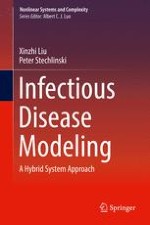2017 | OriginalPaper | Chapter
4. Epidemic Models with Switching
Authors : Xinzhi Liu, Peter Stechlinski
Published in: Infectious Disease Modeling
Publisher: Springer International Publishing
Activate our intelligent search to find suitable subject content or patents.
Select sections of text to find matching patents with Artificial Intelligence. powered by
Select sections of text to find additional relevant content using AI-assisted search. powered by
